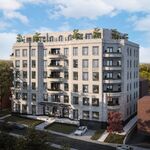Fresh Start
Banned
^ I think that any Eglinton subway plan that does not reach the airport, defeats the purpose of Eglinton subway. Everything else but the airport connection, can be handled quite well by the LRT. At the same time, a mixed-traffic bus connection to the airport from a midway terminal is inferior to a continuous LRT link.
A subway from PIA to the DVP is a better idea. However, the suggestion that those 24 km can be built for less than 5 B is way too optimistic, given the projected per-km cost of Spadina extension (even if those 6 km in Richview can be built somewhat cheaper).
How do you figure that? The costs to build the YUS extensions are hyper-inflated and ergo make for an unfair comparison as to what can be accomplished along Eglinton. What part of the Eglinton subway alignment has to tunnel beneath a riverbed or highway system or require a new storage facility or mass 27-bay underground bus terminal or be exclusively in a tunnel bore?
I'm going to try my best to rationalize how building the subway actually SAVES money in contrast to Transit City and several other schemes to get mass transit to the airport. Making Eglinton compatible with HRT technology means that Eglinton trains can utilize Wilson Yard, minimizing the need for a separate storage facility as Wilson still has spare capacity. Davisville Yard is a possibility as well, only one kilometre south of the corridor.
By the way on the issue of transferring, where do you think more people will desire to do so: 5 minute long waits at road median LRT sheds exposed to the elements or climate-controlled stations where trains show up every 2’35’’ or better? If your answer is B, please read on. If roughly half of all southbound trips for major intersecting TTC bus routes (from west to east: 58, 112, 46, 191, 45, 37, 79, 89, 41, 29, 7, 61, 11, 56, 88, 51, 54 and 100) saw majority passenger drop-off at Eglinton, then that’s a steady guaranteed source of ridership. Crunching the numbers: a total of 85,167ppd or 5323pphpd (SOURCE: http://www3.ttc.ca/PDF/Transit_Planning/service_improvements_2008.pdf).
And note that’s just from non-TC prioritized north-south feeder bus trips alone, not accounting for Jane, Don Mills or Eglinton East’s massive levels of riders that’d also directly feed into an Eglinton subway. Then consider Mississauga Transit routes- 11, 17, 27, 35, 50, 57, 82, 89, 109 adding in another 10,000+. The Mississauga Transitway will also attract new ridership, those seeking the Point A - B reliability that comes with the subway, not meandering surface trams. This could all lead to the western termini, handling levels of daily boardings not unlike what Kipling and Islington Stns on the Bloor Line are experiencing today.
Even the staunchest Transit City supporter agrees that the Cross town LRT will eventually need to be retrofitted to subway technology once ridership exceeds capacity, which is expected to happen within 50 years time. Should we wait until then to fix the problem or resolve an issue before it even manifests? Sheppard subway was also considered by many a failure due to its initial lower than anticipated daily usage but look at it now and that's not even a full-length route like Eglinton would be. Surely the demand levels for the airport and northern Mississauga; the Eglinton commercial and retail districts; the ACC, Leaside and Wynford employment centers; and OSC are enough of a draw to fill trains when Sheppard inherently lacks major trip-generators sans Fairview.
And how is one singular subway line which can in fact be seamlessly interlined with the Downtown Relief Line at Mt Dennis to offer direct, continuous rapid transit between PIA and Union/Central Business District; any worse than this overly complicated and expensive, somewhat unwarranted commuter rail scheme?
http://transit.toronto.on.ca/archives/weblog/2009/01/22-will_train.shtml
- Building about 25 kilometers of new rail between Maltolinton n and Union Station, with three new tracks north of Dundas Street West in Toronto and four new tracks between Dundas Street West and a point just east of Strachan Avenue.
- Widening 14 bridges, eliminating all street-level road crossings and building new grade separations at Strachan Avenue, Denison Road and Carlingview Drive;
- Moving the Weston GO Station southward from John Street to Lawrence Avenue West and upgrading the station to serve both GO and Union - Pearson trains;
- Protecting the Weston community by maintaining links between both sides of the railway tracks and building a railway tunnel. GO and Union - Pearson trains will pass through the tunnel after leaving Weston Station. The tunnel will allow Church and King Streets to remain open, resulting in fewer rail-crossing delays for pedestrians and motorists. The project would eliminate the current street-level crossing at John Street and close John to motorists. A new overpass will help pedestrians walk between both parts of John.
- Modifiying GO’s Bloor Station (east of Bloor and Dundas Streets West) to accommodate GO and Union-Pearson trains. (Metrolinx’ media backgrounders and webpages also suggest — but don’t specifically spell out — that upgrading Bloor Station would also include a link to the TTC’s 2 Bloor - Danforth subway at Dundas West Station.)
- Designing a future station where the line crosses Eglinton Avenue West in the Mount Dennis community to allow passengers to connect with the TTC’s Eglinton - Crosstown light rail Transit City line.
- Designing a possible future station at the Woodbine racetrack and future entertainment complex. (This station may also allow passengers to connect with the TTC’s Finch West - Etobicoke light rail Transit City line.)
- Building a 3.3 kilometer-long rail spur from GO’s Georgetown Line to Pearson’s Terminal 1 with seven grade separations;
- Building a a new passenger station at Terminal 1 (Depending on the final Transit City routes, this station may also allow passengers to connect with the TTC’s Etobicoke - Finch West and Eglinton Crosstown light rail Transit City lines.)
- Revising the original Blue 22 proposal so that the line includes stops at Weston and Bloor Stations. This will allow passengers from areas other than downtown Toronto to travel more easily to and from the airport;
- Designing, and possibly building, a new yard for repairing and maintaining Union - Pearson rail link trains;
Is all that really necesary when only 17% of Pearson travellers originate from downtown? Would it not just be better to provide rapid transit to some intermediate destinations along the way as the subway can allot? The directness of a seamless DRL-Eglinton subway interline ride with more conscientious stop spacing than Transit City is more beneficial to commuters as a whole whilst being less disruptive to motorists and the community of Weston.
Finally, Eglinton need not cost the City a mint. In fact seeing as the Cross-town LRT is projected to cost $ 5 billion for 30 kilometres, getting 24 kms of subway instead for roughly the same price isn’t that bad of a deal. The central tunneled section of the line has already been estimated at $2.2 billion total. But let us entertain for a second that swapping LRTs for HRT will magically extrapolate the costs. Going by the Spadina extension’s $265 million/km budget, we’ll say it’s $3.180 billion for the 12 km central tunnel. Now the section through all of Etobicoke and east of Brentcliffe would be at-grade or above-grade areas of track. Very generously I’ll say this comes to $200 million/km for the remaining 12 kilometres. That’s still only $5.580 billion total!




